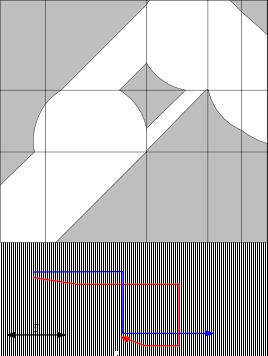 | ||
In mathematics, the Fréchet distance is a measure of similarity between curves that takes into account the location and ordering of the points along the curves. It is named after Maurice Fréchet.
Contents
Intuitive definition
Imagine a dog walking along one curve and the dog's owner walking along the other curve, connected by a leash. Both walk continuously from their respective start point to their end point, varying their speed but not backtracking. The Fréchet distance between the two curves is the length of the shortest leash sufficient for traversing the curves: not the shortest leash sufficient for all walks, but the shortest for a leash-minimizing walk.
The definition is symmetric with respect to the two curves if you imagine the dog walking the owner.
Formal definition
Let
Let
where
Informally, we can think of the parameter
The Fréchet metric takes into account the flow of the two curves because the pairs of points whose distance contributes to the Fréchet distance sweep continuously along their respective curves. This makes the Fréchet distance a better measure of similarity for curves than alternatives, such as the Hausdorff distance, for arbitrary point sets. It is possible for two curves to have small Hausdorff distance but large Fréchet distance.
The Fréchet distance and its variants find application in several problems, from morphing and handwriting recognition to protein structure alignment. Alt and Godau were the first to describe a polynomial-time algorithm to compute the Fréchet distance between two polygonal curves in Euclidean space, based on the principle of parametric search. The running time of their algorithm is
The free-space diagram
An important tool for calculating the Fréchet distance of two curves is the free-space diagram, which was introduced by Alt and Godau. The free-space diagram between two curves for a given distance threshold ε is a two-dimensional region in the parameter space that consist of all point pairs on the two curves at distance at most ε:
The Fréchet distance
Variants
The weak Fréchet distance is a variant of the classical Fréchet distance without the requirement that the endpoints move monotonically along their respective curves — the dog and its owner are allowed to backtrack to keep the leash between them short. Alt and Godau describe a simpler algorithm to compute the weak Fréchet distance between polygonal curves, based on computing minimax paths in an associated grid graph.
The discrete Fréchet distance, also called the coupling distance, is an approximation of the Fréchet metric for polygonal curves, defined by Eiter and Mannila. The discrete Fréchet distance considers only positions of the leash where its endpoints are located at vertices of the two polygonal curves and never in the interior of an edge. This special structure allows the discrete Fréchet distance to be computed in polynomial time by an easy dynamic programming algorithm.
When the two curves are embedded in a metric space other than Euclidean space, such as a polyhedral terrain or some Euclidean space with obstacles, the distance between two points on the curves is most naturally defined as the length of the shortest path between them. The leash is required to be a geodesic joining its endpoints. The resulting metric between curves is called the geodesic Fréchet distance. Cook and Wenk describe a polynomial-time algorithm to compute the geodesic Fréchet distance between two polygonal curves in a simple polygon.
If we further require that the leash must move continuously in the ambient metric space, then we obtain the notion of the homotopic Fréchet distance between two curves. The leash cannot switch discontinuously from one position to another — in particular, the leash cannot jump over obstacles, and can sweep over a mountain on a terrain only if it is long enough. The motion of the leash describes a homotopy between the two curves. Chambers et al. describe a polynomial-time algorithm to compute the homotopic Fréchet distance between polygonal curves in the Euclidean plane with obstacles.
Examples
The Fréchet distance between two concentric circles of radius
